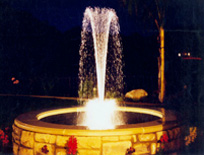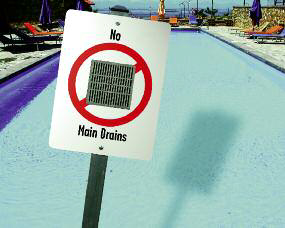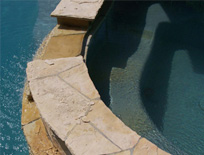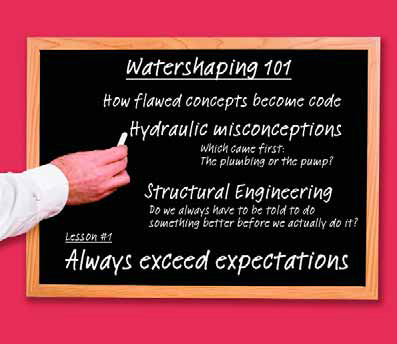hydraulics
This lesson involves the performance of a simple but elegant aboveground fountain. As is true of all watershapes, fountains need to be built in such a way that they reliably hold water and don’t leak. That’s an obvious given, of course, but water being the clever devil it is, if you miss
Part I: Setting the Course Theatrical vitality has to do with structuring stories and creating dramatic narratives that establish sensations of expectation, surprise and reward. It also involves the development of sympathetic, interesting characters as well as engagement in “the moment” – the feeling that a special and wonderful entertainment experience is unfolding before the audience in a specific time and place. Mastering all of that is a tall order under ordinary circumstances, so you can imagine how we felt in trying to help make it happen on the exposed, unpredictable stern deck of Oasis of the Seas – a prestigious ship that currently claims the title of world’s largest cruise liner. Fluidity – a Los Angeles-based water design studio – pursues unique, progressive projects for an international clientele that includes architects, landscape architects, civic institutions and real estate developers. Through the years, we’d had considerable experience with theatrical
The following is the text, somewhat altered for this audience, of a letter I’ve sent a number of health departments in the course of working on projects for our clients. There is no doubt that the recent wave of legislation, codes and standards regarding suction entrapment has caused confusion – not just in the pool and spa industry, but also among lawmakers, inspectors and contractors as well as pool and spa owners. These mandates, however well intended, have all too often been confusing or contradictory and frequently reflect neither
Water passing from one level to another will always be a popular feature in watershapes — from the familiar spillways from spas into pools to the intricate flows found in many fountains, reflecting pools, runnels, rills and even koi ponds (to name a few possibilities). Depending on the application, these features might
During the past year, I’ve had the pleasure of teaching hydraulics to watershapers in a variety of classroom settings. It’s been exciting, believe me, particularly because of the eagerness of the students and their hunger for good information. These courses, which have been presented under the auspices of Genesis 3, ask a lot of the students who sign up for them. Especially given the tight economy, I find it enormously encouraging that so many people are focused on spending the time and energy required to
It seems like ages ago, those glowing days when a spa – whether separate from or connected somehow to a swimming pool – stood on the absolute cutting edge of residential watershaping. These days, by contrast, systems designed to deliver hot water and hydrotherapy to our clients have become so familiar that they’re almost taken for granted. From what I’ve heard, it’s almost reached the point where discussions leading up to some of the best custom projects are treating spas as
In most watershapes, we circulate and treat water through use of pumps and filters – and although we still don’t think about it much these days, we do so because fresh water is in precariously short supply and we can’t simply fill and dump it as we please. Yet even a perfect watershape – that is, one devoid of leaks, never subject to splash-out and never in need of backwashing – occasionally requires the addition of new water if only because evaporation will carry it away, bit by bit. In fact, there’s no way to cut Mother Nature out of her share, or to keep her from
As a rule, I avoid working for contractors: I’ve found that far too many of them spend so much time worrying about the bottom line that they lose sight of the fact that their clients want quality rather than compromises. I’ve also found that their general caution is often at its worst when it comes to watershapes: Even though these structures may be key components of the overall project, they tend to come along late in the process and are all too often seen as places where corners can be cut to meet overall budget goals. Frankly, I’ve never liked being treated as a pawn or second-class citizen, so I avoid these situations like the plague. Instead, I typically work directly for homeowners and refuse to subordinate my part of a project to the whims of another contractor. Any worthwhile rule, however, has
One of the things I love about my chosen profession is that no two days are exactly alike: Instead of installing the same design in the same way day after day, I’m constantly forging ahead, taking new paths, moving in new directions. With these explorations come many opportunities to learn new techniques and work through new ideas. And I like the fact that I’ve built a reputation as someone who enjoys pushing the envelope and trying out approaches I haven’t
Where do rivers start? That’s a question that has always fascinated me, basically because I know that the Nile, the Amazon and the Thames – as majestic and life-giving as they and many of the world’s other great rivers become – all begin as mere trickles. Indeed, with the notable exception of rivers that erupt from the ground as powerful streams, most great rivers start out as subtle emanations of water that has migrated, globule by globule, through vast areas of porous rock to emerge as tiny rivulets in zones known as “spring lines.” These spaces typically exist between






















